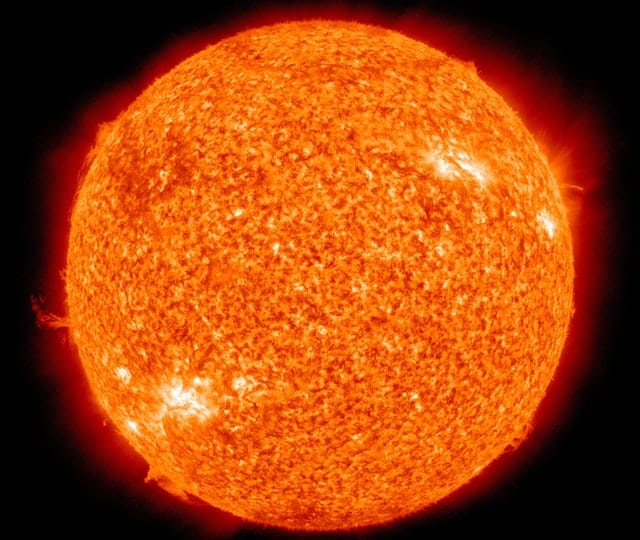40+ Stupendous Facts About the Sun

The Sun controls all aspects of our lives: Our food, our climates, and our bodies. We literally live inside the Sun’s atmosphere. We, as well as other planets, satellites, and other objects in the solar system, are greatly influenced by the Sun. The Sun is growing more powerful every day and scientists project that in the next 4 billion years, it could devastate the Earth and other planets.
This is evident by the solar super storms that happened many years ago. However, despite its supremacy and danger, man’s quest to find more about it has never died down. Here are amazing facts about the Sun that scientist have since made available to us:
Fact 1. The Sun forms the bulk of the solar system in regard to mass (99.8%), leaving only 2% for the rest of the formations to fill in. It’s mass is approximately 330,000 times greater than that of Earth
Fact 2. Each second, the Sun consumes 4 million tons of hydrogen, which explains why the Sun is made up of 78 % hydrogen, 23% helium and 2% heavier elements.
Fact 3. The diameter of Sun is about 1,392,684 kilometers while its equatorial circumference is close to 4,370,005.6 km.
Fact 4. The Sun rays reach the earth in about 8 minutes despite the distance between them. The distance between the Sun and the earth is approximately 92, 935, 700 miles.
Fact 5. All the nine planets (Mercury, Venus, Earth Mass, Jupiter, Saturn, Uranus, Neptune, Pluto) in the solar system orbit the Sun. However, Pluto has since been scratched out of the list of planets.
Fact 6. Scientists estimate that the Sun is about 4.5 billion years old. They project that the Sun will still shine for the next 5 billion years before it uses up all the hydrogen.
Fact 7. We all know that the Sun rises from the east and sets in the west, but we don’t know why. We’ll; it’s because the earth rotates, and is not due to the movement of the Sun. The phenomenon is similar in both the Northern and Southern Hemisphere.
Fact 8. The Sun’s core experiences a temperature of 15 million degrees Celsius or 27 million degrees Fahrenheit.
Fact 9. The Sun has a diameter of approximately 870,000 miles wide, which makes it 109 times wider than Earth. It’s also 33,000 times heavier than Earth.
Fact 10. The gravity of the Sun is 28 times more than of Earth, which means if you weigh 150 pounds on Earth, you would weigh 4,200 pounds on the Sun.
Fact 11. Although a lot of evidence point to the fact that fluctuation in solar activity is able to impact climate on Earth, a greater percentage of astrophysics and scientists converge to the view that the Sun is not to blame for the present and historically rapid increase in world temperatures on Earth. They have chiefly been contributed by humans.
Fact 12. The earth is huge, but the Sun is significantly bigger. Scientists have estimated that 960, 000 earths would comfortably fit inside the Sun’s interior.
Fact 13. Most cultures idolize the Sun. Through human history, we’ve seen that many communities, for instance, ancient Aztec, Indo-Europeans, Meso-American and Egyptian cultures, all worshiped the Sun as a god.
Fact 14. It is estimated that after every 11 years, some sort of flare or spark occurs on the surface of the Sun. These sparks or flares are caused by electrons colliding with other particles within the Sun. This is shown by a certain flash or brightness from the surface of the Sun. These solar flares can interrupt satellite communication and interferes with electricity on planet earth.
Fact 15. The energy generated by the Sun is so vast that it would take the detonation of 100,000,000,000 tons of dynamite to replicate that amount.
Fact 16. The first human to claim that the Earth is orbited by the Sun was Greek philosopher, Aristarchus.
Fact 17. The first human to claim that the Sun is a star was a Turkish Philosopher called Anaxagoras. This was around 450 BC.
Fact 18. The Sun rotates on its axis once every 25.38 Earth days or 609.12 hours
Fact 19. The Sun is the largest object in the entire solar system.
Fact 20. The Sun lacks a definite boundary, and in its outer section, its density reduces rapidly with increasing distance from its center.
Fact 21. Each day, the Sun transmits ten times more neutrinos to earth than the total number of people present on earth.
Fact 22. A third of the entire Russian Population holds the view that the Sun rotates around the earth.
Fact 23. Plants convert sunlight into energy every day. This energy combined is equal to six times the total power consumed within human civilization.
Fact 24. A single bolt of lightning is considered five times hotter that the Sun’s surface.
Fact 25. About 59 years ago, the Catholic Church forced Galileo Galilei to take back his sentiment that the earth revolves around the Sun. However, in 1992, the church made a U-turn and said Galileo was right.
Fact 26. Of all the objects occurring in the universe, scientists found that the Sun is the perfectly round object known to humans.
Fact 27. Proxima Centauri is the closest star to the Sun. However, it’s still miles away from Pluto, by far.
Fact 28. The Sun is composed of different layers. On the outside, the Sun looks pretty much like a ball of fire. However, the Sun has an internal structure. The visible surface seen by the naked eye is known as the photosphere. The photosphere can heat up to a temperature of approximately 6,000 degrees Kelvin.
Underneath the photosphere is the convective layer, where heat travels gradually from the inner Sun to the surface, and cooled material subsides back down in columns. Underneath the convection layer is the radiative zone, where heat only travels through radiation.
The next layer is the Sun’s core, which extends from the center of the Sun to an estimated distance of 0.2 solar radii. This is a zone where temperatures hit 13.6 million degrees Kelvin and hydrogen molecules are fused into helium.
Fact 29. Pluto takes a whopping 248 years to orbit the Sun.
Fact 30. It is projected that in the next 5 billion years, the Sun will use up its hydrogen and helium supply, transforming into a red giant star, destroying Mercury and Venus, and probably even earth.
Fact 31. An estimated 30% of solar radiation is normally reflected back to space and the remaining absorbed by land masses, clouds, and oceans.
Fact 32. If you could get rid of the bright, glowing surface of the Sun, you would only see blackness. This means that only the outer surface of the Sun shines brightly. The inside of the Sun is totally black.
Fact 33. The powerful gravitational pull of the Sun is the reason why even the farthest dwarf planet (Pluto), which is estimated to be 5, 900, 000, 000 kilometers away, is still kept in the Sun’s orbit. Also, other dwarf planets exist that are farther away than Pluto yet they are kept in the Sun’s orbit.
Fact 34. It is estimated that a flight from Earth to Sun on an airplane, flying at its average speed of about 644 km per hour without stopping), would take you 20 years.
Fact 35. A sunspot is a magnetic storm on the surface of the Sun that appears as a dark patch. It’s about 1500 degrees Celsius cooler than any material surrounding it.
Fact 36. A sunspot is typically darker when compared to the Sun. However, a sunspot would glow brightly in front of a dark background.
Fact 37. A full solar eclipse, a phenomenon that takes places when the new moon passes in between the Earth and the Sun and casts its darkest shadow on the face of the earth, can last for seven and a half minutes.
Fact 38. Statistically, 2 to 5 solar eclipses occur every year.
Fact 39. The amount of energy given off from 1 cm of the surface of the Sun can burn 64 100-watt light bulbs.
Fact 40. Solar wind is an endless flow of charged particles, which are emitted from the Sun and thrown outwards into space at an estimated speed of 800 kilometers per second. Solar winds are commonplace after a solar flare phenomenon.
Fact 41. The Sun produces solar wind. The solar wind is composed of charged particles like electrons and neutrons. The solar wind is able to reach earth due to its strong kinetic energy, which allows it to plow through the gravitational force.






